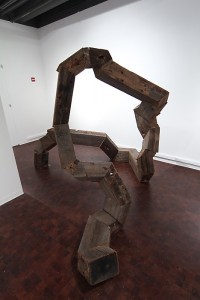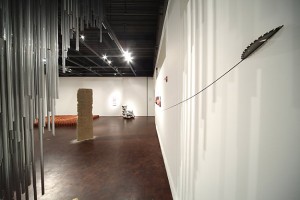We first saw Randy Colosky’s work at Ampersand Gallery in San Francisco and couldn’t be happier to see it again at MOCFA. One of our favorite pieces by Colosky challenges the actual confines of the museum space in which his work resides by taking a circular saw to the museum wall, leaving the blade half exposed and the line incomplete. Maybe it’s a comment on the “white cube” and all that it has come to mean – maybe not. But either way, we like it. To get you all ready for Randy Colosky’s artist talk this Saturday at the Museum of Craft and Folk Art, we’re sharing this great interview with MOCFA Curator Natasha Boas and the man himself, Randy Colosky. Check out their website for more information on the talk this Saturday, but word is – it’s from 2 to 4pm.
Interview with Randy Colosky & Curator Natasha Boas
Courtesy of the Museum of Craft and Folk Art for SFAQ
Bay-Area conceptual artist Randy Colosky works with exacting physicality using commonplace and industrial materials with a strong emphasis on the architectonic. Altering the standard functions of traditional craftsman processes, Colosky delves into the character of materials and craft methodologies by dissecting their codes and activating them with new ideas and associations.
MOCFA is proud to present newly commissioned work in a range of materials and media including aluminum, engineered ceramic, brick and reclaimed wood as well as drawing and video. Curator Natasha Boas interviewed the artist in his studio in Oakland to discuss the new work.
![]()
Natasha Boas: Randy, when I think of your work I think of the Richard Artschwager quote: “I am making objects for non-use…by killing off the use part, non-use aspects are allowed living space, breathing space.”
Randy Colosky: I love this, I really relate to it, its part of my practice for sure. I like to use materials that are familiar to a wide range of people but show that the materials in and of themselves are design elements and content or that their function can be elevated to a higher plane of thought or optical dynamic, like the Axis Mundi piece or the Barbican piece. You know Artschwager was a furniture maker at one point in his life and had intimate knowledge of those materials, I think that’s why it can’t really be imitated. I love his work.
NB: FIAT LUX marks a shift in your practice from say your Ampersand show of last year. Is it the scale or the focus that has changed for you? I see the works in FIAT LUX as very clearly articulated and related to each other, as if you have moved to another level of practice.

Randy Colosky's "The Pressure to Hold Together That Which Held Things Back" (2011), salvaged wood sculpture, uses retaining wall timbers.
RC: The deviation—if you want to go there—between the two shows for me is that the work in the Ampersand show was more cerebral. The scale of the works was designed so they could be absorbed and reasoned with. The Ampersand show was also a revisiting of ideas that I had been working around for many years that finally found a place to be fully expressed without any attenuation.
The opportunity you have presented me with a commissioned show at MOCFA sort of opened my Pandora’s box. This show is also cerebral in the same way, but it’s loaded with a lot of emotional content. I think this has evolved out of the validation that I received from the Ampersand show after hanging around the art world for so long (pause), and now I feel more liberated to share that part of myself in the work. So in regards to the scale of the works yes, there are some that are larger in scale because with greater emotion come greater gestures.
NB: You have a traditional art-school background in ceramics as well as hands-on experience with building. How do both of these paths converge in FIAT LUX?
RC: My art history in school was more about the cultural history of ceramics, which at its base is about form, function and design. Working in the building trades, ceramic industry, set building and as a cook in restaurants, you have no choice but to find the most economical ways to get things done which is also a predominant theme in the history of ceramics. In my occupations, I have had to do a lot of design or process problem solving. What happened for me working construction jobs is that I began to see the interesting formal aesthetic moments in the materials and processes of work I was doing. Seeing giant orderly stacks of building materials, smoothing plasters with slightly different colors in them or when I was a cook, watching the swirl of different color liquids mixing in a giant vat with the steam rising up, became inspiring and the line between what art was and what I was doing as an occupation became blurred.
Now the sense of discovery in my work comes through working this line with materials. For example, the engineered ceramic piece “Barbican” is made of a material that is manufactured for purely industrial purposes but has some unique optical and sculptural properties that offer an opportunity for the viewer to personally connect with the work beyond any theoretical concepts.
NB: You have some central themes in FIAT LUX—can you address some of them? Modular repetitions, tension, optical qualities of materials, use of empty space?
RC: Well, the elements in your list are for me poetic design tools to get at something more elusive. Fiat Lux is more an overall theme of the show, which directly translates to “Let light be made.” This concept for me is my way of attempting to find ways of aligning myself with what I see is the larger creative force that is our existence– and then exploring ways to share the inspiration I feel working on art. So utilizing concepts like iteration, fractals, quantum mechanics, chemistry, biology, physics, scale (and the list goes on and on) help me try to understand, in a more intimate way, the nature of what we are. By creating physical manifestations of these ideas, however awkwardly, helps me move toward this concept of Fiat Lux.
NB: There is a strong spiritual element to the work. Axis Mundi is a direct reference to the cosmic axis in religion or mythology, the connection between Heaven and Earth, the higher and lower realms. The image appears in art history in both religious and secular contexts. You have expressed to me that it is important that art engages spirituality as a central part, not in a religious way, but in the largest humanist way.
RC: Well first off, to be honest, I didn’t know what Axis Mundi was when I was making the piece (laughs). The concept for the piece started around the idea of how rain falling for some can cause a catastrophic situation but for others rain falling can be a solution to a catastrophic situation –but in the end the rain is rain either way. The overall idea was based in Buddhism and how natural elements function in our world.
But when my assistant Alison OK Frost and I started physically working on the piece, it started to take on this quality of an apparition like a ghost floating in the air between two places. She referred to it as the “Axis Mundi” and I was like, what’s that? (laughs). So it became the title of the piece.
There is a point I would like to clarify here (pause) and that is that my own experience with my work is not an experience that I expect viewers to have. I think Axis Mundi is a nice overall concept title for how the piece functions in idea and appearance, but I really try to make my work as economical as possible in regards to narrative or reference. Part of why I have become so interested in artists like Fred Sandback, Richard Long and Agnes Martin and the other minimalists, is that their works– although very theoretical– allowed the viewer to ultimately have his or her own reaction. So yes, the piece for me is about the idea of dimensions overlapping, which could be about heaven and earth or it could easily be about something like neutrinos passing through the earth.
NB: You don’t really make a separation between your artistic practice and your life?
RC: A lot of the underlying ideas of why my pieces exist revolve around the ideas of contradiction, tension, impulse control and transformation. One example in the show is the redwood piece which is titled ” The Pressure to Hold Together That Which Held Things Back” The wood was actually salvaged from a retaining wall in Walnut Creek and was literally used to hold something back, and I have made this piece with bolts that actually hold the piece together with the force of pressure. But it’s more than that for me, it’s a physical manifestation of how in the past I would build up these formidable angry walls in my mind against things and then it would take all this energy to maintain the walls. As I get older, with a lot of help and the incorporation of some very basic spiritual principals, I am now able to manifest these experiences in my work.
